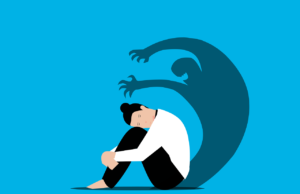Pandemic-driven isolation and financial concerns have caused a huge increase in mental health issues, including depression and anxiety. Another contributor to mental health issues is the continuing cycle of “high” and “low” risk status for geographic areas throughout surges of new Covid variants. If you’ve never had mental health issues before, but are feeling “off,” you may find yourself wondering, could it be depression, anxiety, or both?
The extent of the problem is huge. A national study launched in March 2020 found 27.8% of adult participants reporting symptoms of depression. This was over three times the national pre-pandemic depression estimates of 8.5%. A year into the Pandemic, depression rates climbed even higher. In April 2021, the percentage of people in the study reporting symptoms of depression rose to 32.8%.
While many of these study participants may be having their first brush with mental health issues, these conditions are actually quite common. Anxiety-related disorders are the most common mental illness in the United States. Major depressive disorder is also common. Both conditions often occur together because one predisposes you to the other, according to Deborah Serani, PsyD.
That may be because studies show that people who have major depressive disorder and generalized anxiety disorder share the same genetic and neurobiological factors. Behavior may play a role as well. If you have anxiety, you may avoid potentially stressful situations and become isolated, which can then lead to depression. If you’re depressed, you may stop doing what you enjoy due to low mood and lack of energy. When you attempt to return to those activities you may feel out of place, which can result in nervousness and anxiety.
Anxiety
Anxiety typically involves constant worry. It’s normal to be anxious sometimes but anxiety goes beyond that and is an ongoing pattern. Symptoms of anxiety can include:
- Excessive worrying about things going wrong
- Fear of losing control
- Racing thoughts
- Poor concentration
- Becoming easily distracted
- Elevated heart rate
- Shortness of breath
- Dizziness and lightheadedness
- Digestive upset
Many people suffer from generalized anxiety disorder, but there are other specific types of anxiety disorders depending on what makes you anxious. A common type is social anxiety, the feeling of worry or fear in social interactions. Panic disorder involves sudden occurrences of rapid heartbeat, sweating, or difficulty breathing. Some also consider Post-traumatic Stress Disorder (PTSD) to be an anxiety disorder.
Depression
Depression is characterized by persistent sad, hopeless, or empty feelings that last for more than two weeks. When these feelings persist like this, they have shifted into real illness, not something that you can just “snap out of.” Depression is classified as a mood disorder because it affects your emotional state. If you have depression, you may experience some or all of the following symptoms:
- Feeling hopeless or pessimistic
- Irritability
- Loss of interest in hobbies or pleasurable activities
- Moving or talking more slowly than usual
- Decreased energy
- Difficulty concentrating
- Difficulty sleeping
- Aches and pains or digestive issues without another cause
Related Reading: Can Depression and Anxiety Make You Sick?
What Causes Depression and Anxiety
These conditions are complex and their exact causes differ from person to person. However, five main underlying causes contribute to the development of depression and anxiety.
- Family history If you have a history of depression and anxiety on one or both sides of your family, you are at higher risk of developing these conditions. As to whether it’s “nature or nurture,” it’s probably both when it comes to family history. There is a genetic aspect to this increased risk, as well as an element of the family of origin environment and what thinking patterns were modeled for you.
- Childhood trauma When you experience trauma in childhood, the “wiring” in your nervous system is changed. You become more attuned to threats in your environment, and your body’s natural fight/flight/freeze responses can become “stuck” in the “on” position if the traumas were large or chronic. If your system is stuck in flight, you may experience chronic anxiety. Being stuck in fight or freeze can drive chronic depression.
- Brain structure Theories on biochemical imbalances have gone out of favor in the scientific community, nevertheless, the brain is still the main player when it comes to depression and anxiety. Brain imaging shows that depression sufferers have less active frontal lobes in their cerebrum and actually show differences in the size of their brains versus the brains of non-depressed people. It’s unclear if this occurs before or after the onset of depression symptoms. Also, anxiety and chronic stress are associated with degeneration and impaired functioning of the hippocampus and the pre-frontal cortex areas of the brain.
- Medical conditions If you have certain medical conditions, you may be at higher risk for developing anxiety and depression. Cardiac issues, ADHD, sleep disorders, and chronic pain conditions are among many that can put you at higher risk.
- Medication use Some medications are associated with developing anxiety or anxiety-like symptoms. For example, corticosteroids, ADHD medications, asthma medications, thyroid medications, anti-seizure medications, and drugs for Parkinson’s Disease can trigger anxiety. Depression is associated with the use of corticosteroids, beta-blockers, benzodiazepines, some hormone-altering drugs, statins, and many more. If you have a family history of either depression or anxiety, make sure your physician knows so he or she can prescribe with this in mind.
Depression and Anxiety Comorbidity
When both depression and anxiety occur together, they are said to be comorbid. Both conditions can make it hard to perform everyday tasks without getting overwhelmed. That’s because anxiety and depression both cause difficulty focusing and concentrating. But how they affect those cognitive tasks aren’t the same. With depression there is a slowness of thinking and focus due to underactivity in the frontal lobe of the brain. With anxiety, certain brain functions and neurochemistry put you into a heightened state of alert, which impedes concentration.
Treatment for Anxiety and Depression
A main component of treatment for anxiety and depression is psychotherapy. Although psychotherapeutic treatments for the two conditions can be similar, it’s important that your therapist correctly identifies your condition in order to tailor their approach to the problem. For example, if you are depressed you may feel stressed. This can look like anxiety when actually it’s tenseness or restlessness. Your therapist will target those things differently.
Related Reading: Can Depression and Anxiety be Cured?
Cognitive Behavioral Therapy (CBT) is typically used for both conditions. CBT focuses on helping you identify and change the thoughts and behaviors that are contributing to your symptoms. When using CBT for anxiety, the goal is to stop you from avoiding situations and help you to dismantle your fears. When used with depression, CBT helps you to experience positive emotions.
Dialectical Behavior Therapy (DBT) is another therapy that can be used for both conditions. Using DBT, you can learn to manage your emotions and how you relate to others with techniques targeted to build emotional regulation, distress tolerance, and interpersonal effectiveness. These techniques are sometimes taught in group therapy but can be taught to you individually, as well.
Doctors may recommend antidepressant medications called selective serotonin reuptake inhibitors (SSRIs) for both anxiety and depression. These medications affect serotonin, a chemical that influences feelings of well-being and happiness. They can help you feel less depressed and anxious, as well as reduce certain physical symptoms such as sleep difficulties.
Another type of medication to ease depression and the physical symptoms of anxiety, such as muscle tension, panic attacks, and restlessness, are benzodiazepines. While “benzos” are fast-acting, the effects don’t last long. Also, they aren’t safe for long-term use as this can increase the chance of physical dependence. So if your physician recommends a benzodiazepine, use caution.
You may be wondering who to see for depression and anxiety. Therapists at Life Care Wellness can determine if you are suffering from depression, anxiety, or both. If you’re in the northern Illinois area and are looking for a depression and anxiety therapist near you, reach out to Life Care Wellness. We have offices in Glen Ellyn, Chicago (Jefferson Park), Sycamore, and Yorkville.
Rhonda Kelloway is the owner and principal therapist at Life Care Wellness, a group psychotherapy practice in Glen Ellyn, Sycamore, and Chicago (Jefferson Park neighborhood), Illinois. She is a trauma specialist utilizing a Somatic Experiencing framework to utilize the body’s wisdom in healing. She also uses EMDR and a variety of traditional psychotherapy approaches in her work. In addition to being a psychotherapist, she is a trained divorce and family mediator.






